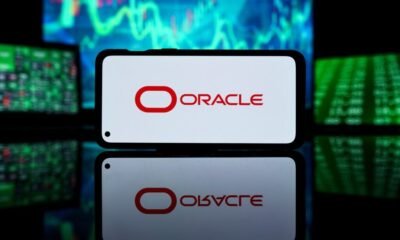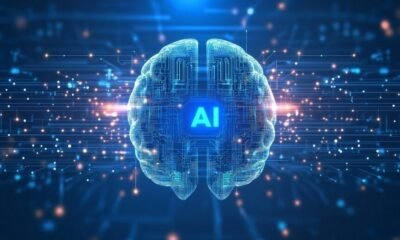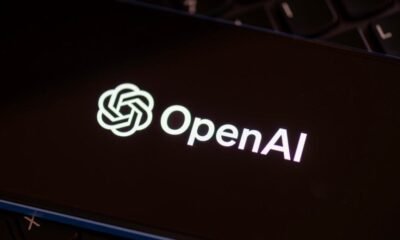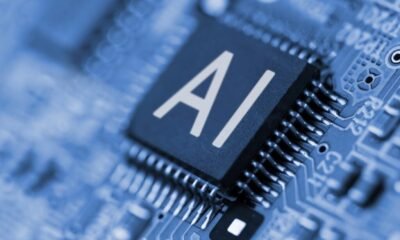Business
Dan Ives Says Tesla’s AI And Robotaxi Business Worth At Least $1 Trillion, Company And Musk Headed For ‘Important Chapter’ In Growth Story – Tesla (NASDAQ:TSLA)

Over the weekend, Wedbush Securities analyst Dan Ives said Tesla Inc. TSLA is on the verge of its most significant phase yet, arguing that the company’s artificial intelligence and robotaxi ambitions could unlock at least $1 trillion in value.
AI Revolution And Robotaxi Potential
“We believe Tesla and Musk are heading into a very important chapter of their growth story as the AI revolution takes hold and the robotaxi opportunity is now a reality on the doorstep,” Ives wrote on X, formerly Twitter. “We estimate the AI and autonomous opportunity is worth at least $1 trillion alone for Tesla.”
Ives’ remarks followed a Wall Street Journal report that Stephen Hawk, a 56-year-old Tesla investor from Florida, had filed a shareholder proposal urging Tesla’s board to approve an investment in xAI.
Following the report, SkyBridge Capital founder Anthony Scaramucci also said that a Tesla–xAI merger “feels inevitable.”
Delivery Momentum Fuels Near-Term Gains
Earlier this month, Gary Black, managing partner at The Future Fund LLC, said Tesla’s stock surge in the past few days stems from expectations that the company will exceed Wall Street’s third-quarter delivery forecasts.
“Let’s not kid ourselves,” Black wrote on X. “$TSLA has been strong the past few days NOT because of progress on robotaxi but because every hedge fund has come to the realization that $TSLA will crush 3Q delivery estimates in two weeks.”
Black estimates Tesla will deliver 470,000 vehicles in the quarter, well above Wall Street’s consensus of 432,000, aided by buyers rushing to take advantage of the expiring $7,500 EV tax credit on Sept. 30.
What Are The Mixed Global Signals
Tesla’s performance remains uneven across markets. In China, sales fell 10% in August, marking the sixth monthly decline in 2025. Still, early September saw a rebound, with registrations hitting 14,300, a 41% jump from the previous quarter’s weekly average.
In the U.S., rising vehicle prices have weighed on Tesla’s market share even as overall EV sales climb.
Skepticism On Autonomy And Leadership
Not all observers are convinced Tesla can deliver on Ives’ trillion-dollar thesis.
Ross Gerber, co-founder of Gerber Kawasaki, earlier questioned Tesla’s approach to autonomy, saying Musk has ignored hardware issues critical to self-driving safety.
An ex-employee also criticized Musk’s leadership as “seriously compromised,” alleging it had damaged Tesla’s mission.
Tesla Stock Lags Behind S&P 500 And Nasdaq 100
In July, Tesla reported second-quarter revenue of $22.5 billion, down 12% year-over-year and short of analyst estimates.
At the time, the company reiterated plans to launch a more affordable model later in 2025 while preparing the Tesla Semi and Cybercab for volume production in 2026.
On the analyst front, Tesla carries a consensus price target of $311.81 based on 29 ratings. The three latest updates include Wedbush, RBC Capital and China Renaissance, with their average target of $391.33 suggesting a slight 1.07% downside.
Price Action: So far in 2025, Tesla’s stock is down about 2%, underperforming the S&P 500’s 11.95% gain and the Nasdaq 100’s 14.66% increase, according to Benzinga Pro.
Benzinga’s Edge Stock Rankings indicate that TSLA continues to show strength across short, medium and long-term horizons, with additional insights available for investors.
Read Next:
Photo Courtesy: Josiah True on Shutterstock.com
Disclaimer: This content was partially produced with the help of AI tools and was reviewed and published by Benzinga editors.
Business
Amazon Bolsters AI Agent Push With 2 Executive Hires: Internal Memos

Amazon is doubling down on its agentic AI ambitions, hiring two senior executives to help build its growing portfolio of developer tools and infrastructure for intelligent agents.
The new hires follow Business Insider’s report in early September that Amazon was getting ready to make a big splash in the AI agent market, sparking a rally in the company’s shares. Amazon’s cloud computing arm, AWS, has made an aggressive move to position itself as a leader in agentic AI, where intelligent software agents build, deploy, and manage complex applications on behalf of users.
David Richardson returns to Amazon Web Services as vice president of AgentCore, the company’s foundational agent infrastructure offering. A 16-year veteran of the cloud giant, Richardson was instrumental in launching AWS’s Serverless business before departing in 2022 to lead developer experience and product platform at Stripe.
Now back, DRR, as he’s known inside Amazon, will oversee AgentCore along with related projects such as the Strands SDK and Agent Builder within Bedrock, AWS’s popular AI platform.
“We expect DRR to start other new exciting efforts in the AgentCore umbrella,” Swami Sivasubramanian, who runs the Agentic AI team at AWS, wrote in a recent internal memo announcing the hire.
Amazon declined to comment.
Joe Hellerstein, a professor at UC Berkeley and renowned database researcher, has also joined AWS as Vice President and Distinguished Scientist, according to a separate internal memo. He will play a pivotal role in advancing Kiro, AWS’s agentic integrated development environment (IDE). Kiro has quickly gained traction, attracting over 100,000 users in its first week of release.
Hellerstein’s academic work includes leadership of the Hydro project, a framework for building distributed systems. At AWS, he will focus on integrating Hydro’s principles into Kiro to strengthen the platform’s reliability and developer appeal.
“Joe will work closely with our customers to understand their needs and translate that feedback into making both Hydro and our products more impactful,” Deepak Singh, an AWS VP who oversees developer agents and experiences, wrote in an internal memo. “We are particularly excited about the possibilities of how Hydro can integrate with Kiro to help our customers build robust, high-performance distributed systems.”
Sign up for BI’s Tech Memo newsletter here. Reach out to me via email at abarr@businessinsider.com.
Business
Fueled by AI Hype, Google Becomes Fourth Company to Pass $3 Trillion Market Cap

On Monday, Google’s parent company, Alphabet, became the fourth company to reach a market value of $3 trillion, and every member of this exclusive club has something in common.
All it took was a rather small 4% rise in shares for the tech giant to hit the coveted stock market benchmark. Rather unsurprisingly, the three previous winners of that title—Nvidia, Microsoft, and Apple—are all titans of the tech industry that have been riding the wave of investor interest in AI, as well.
Alphabet stock had a great start to September after a federal judge concluded earlier this month that the tech giant could keep Chrome despite its monopoly in internet search. The judge’s reasoning for that was that generative AI would eventually pose “a meaningful challenge to Google’s market dominance.”
Google is trying to get ahead of that “meaningful challenge” by fusing AI into its search engine and pouring billions into developing its AI offerings, including its own AI chatbot Gemini.
It seems that investment cashed out for the company. As of Monday morning, Google Gemini is now the number one free app on Apple’s App Store, relegating OpenAI’s ChatGPT to number two status and giving the much-needed push to the company’s stock.
The AI hype is inextricably and intricately linked to the significant stock market returns that these tech giants, and many others, have experienced this year. The trillion-dollar question: Is there an AI bubble?
AI hype driving major gains
The best example of AI hype delivering trillions of dollars of financial gain is perhaps Nvidia, the ultimate AI darling of the stock market. Due to its immense market share in AI chips and the meteoric rise it experienced thanks to the technology, the company is largely considered the face of the AI hype.
Earlier this summer, Nvidia made history as the first company to ever hit $4 trillion market valuation.
Apple, considered the least AI-savvy of the four companies to breach the $3 trillion benchmark, was the first company to ever be worth $3 trillion but is still yet to hit $4 trillion. Meanwhile, both Nvidia and Microsoft have outperformed Apple and already reached that milestone. Microsoft’s breach of the $4 trillion benchmark was also thanks to AI.
Late July, Microsoft posted an earnings report that showed stellar revenue for its cloud computing platform Azure. The stock move following the report pushed Microsoft briefly above $4 trillion market value.
Fellow cloud infrastructure provider Oracle also benefited greatly from an AI-demand-driven stock move. Chairman Larry Ellison became the richest man on Earth last week after Oracle stock skyrocketed more than 42% on news that the company expects to collect half a trillion dollars (and potentially billions of dollars more) in the coming quarter on AI deals alone.
Is there a bubble?
All this is great news for tech companies and their financial metrics, but is it substantiated? That question has been plaguing investors for some time now.
According to some experts (and OpenAI CEO Sam Altman), there is indeed an AI bubble.
“Are we in a phase where investors as a whole are overexcited about AI?” Altman said last month in a dinner with journalists, according to The Verge. “My opinion is yes.”
An AI report from MIT fueled those worries further just a few weeks ago. The researchers shared that despite the push to scale AI in the corporate world, fewer than one in ten AI pilot programs have actually generated revenue gains.
AI is currently deployed mostly by larger firms in select fields. But even there, AI adoption is now declining, according to the latest U.S. Census Bureau findings.
If AI is indeed in a bubble, the burst could be catastrophic. So much is riding on the AI wave right now, including the entire U.S. economy.
In a paper published in July, Fed researchers said that if AI demand does not scale proportionally with investment, it can lead to “disastrous consequences,” and compared it to the railroad over-expansion of the 1800s and the economic depression that followed. Also in July, economist Torsten Slok called the AI bubble of today even worse than the 1999 Dot-com bubble.
Business
Why Walmart Is Emerging As an AI Powerhouse

Analysts have characterized the recent strength in the stock market as an AI rally, but flying under the Magnificent Seven’s radar is Walmart — a company so vast that it literally has its own weatherman.
And as it turns out, the retail juggernaut’s scale and reach are proving to be tremendous assets in the AI race.
That’s because most top AI companies — like OpenAI, Microsoft, Anthropic, or Meta — operate in a primarily virtual space, processing unfathomably complex rivers of information into more digital information. AI-adjacent companies like Nvidia, Intel, and Oracle focus on providing the physical infrastructure upon which the AI machines function. Then there are the companies that are using digital intelligence to deliver physical results through automation and augmented experiences, like Tesla and Amazon.
Walmart, by contrast, has a vast and complicated set of physical challenges to solve as the largest retailer in the US — and the world. Those include everything from cleaning up spills in the dairy aisle to stocking shelves.
“We move billions of items around every month, every year,” Walmart US CEO John Furner said Tuesday at the Fortune Brainstorm Tech conference. He said the company has been developing machine learning tools and other automation projects since around 2015.
Furner said that the company’s AI models and supply chain automation help plan inventory to arrive at the right aisle at the right time, for example. One technique involves creating “digital twins” of each facility to model the movement of merchandise through the system on its way to customers.
Furner also said store associates increasingly have an AI chatbot handy via their handheld devices to help them better set priorities and help customers.
“It’s a combination of people being powered by technology. There’s a lot of judgment to retail and decision-making. And we’re in a very dynamic industry,” he said. “We think this next phase of physical AI in combination with Gen AI is going to be really helpful.”
The company’s head of e-commerce, David Guggina, told the Goldman Sachs Communicopia and Tech conference last week how AI is helping his team run experiments and fulfill orders at an increasingly rapid rate.
Guggina said his team is now able to work at breathtaking speed behind the scenes, too.
“What took a data scientist days or weeks before can now be done in minutes,” he said.
AI also helps ensure that each of the company’s 4,700 stores has the kinds of products best suited to their local markets, slashing delivery times to minutes after a customer places an order.
“We’ve just completed the third inning,” he said by way of the classic baseball game analogy. “So we’re still early with regard to our automation journey in the fulfillment network.”
These digital-to-physical uses of AI are also complemented by a myriad of “micro agents” that handle tasks like tracking local event calendars or monitoring inventory levels.
Walmart, of course, is still fine-tuning its AI approach, and there have been hiccups.
The proliferation of bespoke Walmart-made AI agents eventually started to confuse users, the company told the Wall Street Journal.
The company has rolled many of those micro agents into four “super agents” designed to assist shoppers, merchandisers, programmers, and third-party marketplace sellers.
Still, because Walmart’s 20,000-strong global tech team builds so many of these digital and physical solutions in-house, the company is emerging as an unexpected AI powerhouse.
The company snagged former Instacart exec Daniel Danker in July to accelerate its AI efforts.
It’s also deepening its partnership this month with OpenAI via a new training program for associates and enterprise access to ChatGPT tools for frontline Sam’s Club employees to help operate their warehouse stores more smoothly.
After all, while chatbots might sometimes hallucinate answers, there’s no faking a cold gallon of milk on your doorstep.
-

 Business2 weeks ago
Business2 weeks agoThe Guardian view on Trump and the Fed: independence is no substitute for accountability | Editorial
-
Tools & Platforms1 month ago
Building Trust in Military AI Starts with Opening the Black Box – War on the Rocks
-

 Ethics & Policy2 months ago
Ethics & Policy2 months agoSDAIA Supports Saudi Arabia’s Leadership in Shaping Global AI Ethics, Policy, and Research – وكالة الأنباء السعودية
-

 Events & Conferences4 months ago
Events & Conferences4 months agoJourney to 1000 models: Scaling Instagram’s recommendation system
-

 Jobs & Careers3 months ago
Jobs & Careers3 months agoMumbai-based Perplexity Alternative Has 60k+ Users Without Funding
-

 Podcasts & Talks2 months ago
Podcasts & Talks2 months agoHappy 4th of July! 🎆 Made with Veo 3 in Gemini
-

 Education3 months ago
Education3 months agoVEX Robotics launches AI-powered classroom robotics system
-

 Education2 months ago
Education2 months agoMacron says UK and France have duty to tackle illegal migration ‘with humanity, solidarity and firmness’ – UK politics live | Politics
-

 Podcasts & Talks2 months ago
Podcasts & Talks2 months agoOpenAI 🤝 @teamganassi
-

 Funding & Business3 months ago
Funding & Business3 months agoKayak and Expedia race to build AI travel agents that turn social posts into itineraries





















